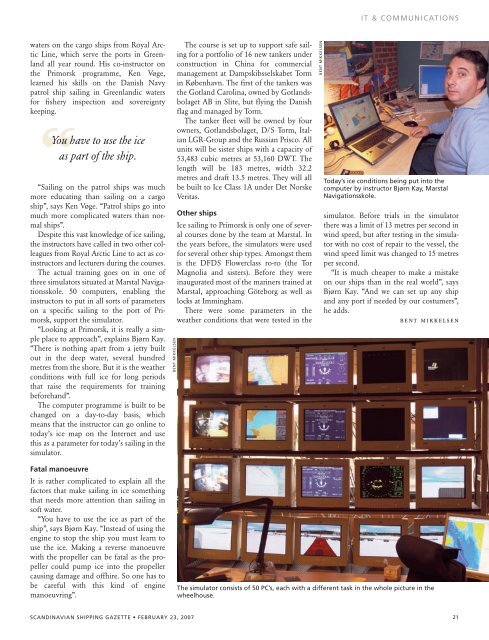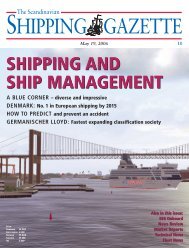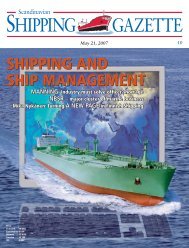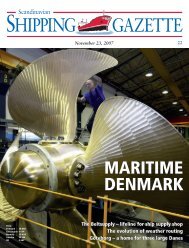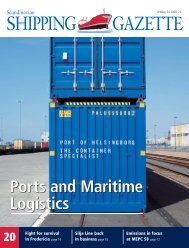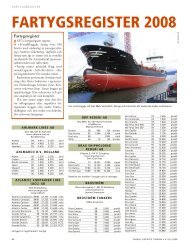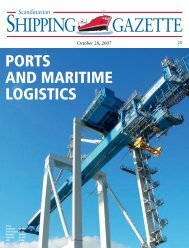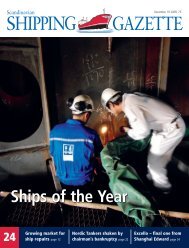SSG No 4 - Shipgaz
SSG No 4 - Shipgaz
SSG No 4 - Shipgaz
Create successful ePaper yourself
Turn your PDF publications into a flip-book with our unique Google optimized e-Paper software.
waters on the cargo ships from Royal Arctic<br />
Line, which serve the ports in Greenland<br />
all year round. His co-instructor on<br />
the Primorsk programme, Ken Vøge,<br />
learned his skills on the Danish Navy<br />
patrol ship sailing in Greenlandic waters<br />
for fishery inspection and sovereignty<br />
keeping.<br />
You have to use the ice<br />
as part of the ship.<br />
“Sailing on the patrol ships was much<br />
more educating than sailing on a cargo<br />
ship”, says Ken Vøge. “Patrol ships go into<br />
much more complicated waters than normal<br />
ships”.<br />
Despite this vast knowledge of ice sailing,<br />
the instructors have called in two other colleagues<br />
from Royal Arctic Line to act as coinstructors<br />
and lecturers during the courses.<br />
The actual training goes on in one of<br />
three simulators situated at Marstal Navigationsskole.<br />
50 computers, enabling the<br />
instructors to put in all sorts of parameters<br />
on a specific sailing to the port of Primorsk,<br />
support the simulator.<br />
“Looking at Primorsk, it is really a simple<br />
place to approach”, explains Bjørn Kay.<br />
“There is nothing apart from a jetty built<br />
out in the deep water, several hundred<br />
metres from the shore. But it is the weather<br />
conditions with full ice for long periods<br />
that raise the requirements for training<br />
beforehand”.<br />
The computer programme is built to be<br />
changed on a day-to-day basis, which<br />
means that the instructor can go online to<br />
today’s ice map on the Internet and use<br />
this as a parameter for today’s sailing in the<br />
simulator.<br />
Fatal manoeuvre<br />
It is rather complicated to explain all the<br />
factors that make sailing in ice something<br />
that needs more attention than sailing in<br />
soft water.<br />
“You have to use the ice as part of the<br />
ship”, says Bjørn Kay. “Instead of using the<br />
engine to stop the ship you must learn to<br />
use the ice. Making a reverse manoeuvre<br />
with the propeller can be fatal as the propeller<br />
could pump ice into the propeller<br />
causing damage and offhire. So one has to<br />
be careful with this kind of engine<br />
manoeuvring”.<br />
The course is set up to support safe sailing<br />
for a portfolio of 16 new tankers under<br />
construction in China for commercial<br />
management at Dampskibsselskabet Torm<br />
in København. The first of the tankers was<br />
the Gotland Carolina, owned by Gotlandsbolaget<br />
AB in Slite, but flying the Danish<br />
flag and managed by Torm.<br />
The tanker fleet will be owned by four<br />
owners, Gotlandsbolaget, D/S Torm, Italian<br />
LGR-Group and the Russian Prisco. All<br />
units will be sister ships with a capacity of<br />
53,483 cubic metres at 53,160 DWT. The<br />
length will be 183 metres, width 32.2<br />
metres and draft 13.5 metres. They will all<br />
be built to Ice Class 1A under Det <strong>No</strong>rske<br />
Veritas.<br />
Other ships<br />
Ice sailing to Primorsk is only one of several<br />
courses done by the team at Marstal. In<br />
the years before, the simulators were used<br />
for several other ship types. Amongst them<br />
is the DFDS Flowerclass ro-ro (the Tor<br />
Magnolia and sisters). Before they were<br />
inaugurated most of the mariners trained at<br />
Marstal, approaching Göteborg as well as<br />
locks at Immingham.<br />
There were some parameters in the<br />
weather conditions that were tested in the<br />
BENT MIKKELSEN<br />
Today’s ice conditions being put into the<br />
computer by instructor Bjørn Kay, Marstal<br />
Navigationsskole.<br />
simulator. Before trials in the simulator<br />
there was a limit of 13 metres per second in<br />
wind speed, but after testing in the simulator<br />
with no cost of repair to the vessel, the<br />
wind speed limit was changed to 15 metres<br />
per second.<br />
“It is much cheaper to make a mistake<br />
on our ships than in the real world”, says<br />
Bjørn Kay. “And we can set up any ship<br />
and any port if needed by our costumers”,<br />
he adds.<br />
bent mikkelsen<br />
SCANDINAVIAN SHIPPING GAZETTE • FEBRUARY 23, 2007 21<br />
BENT MIKKELSEN<br />
IT & COMMUNICATIONS<br />
The simulator consists of 50 PC’s, each with a different task in the whole picture in the<br />
wheelhouse.


